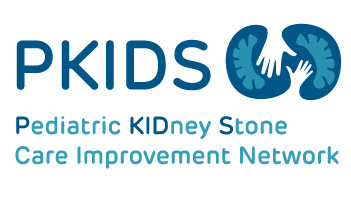HOW CAN WE HELP YOU? Call 1-800-TRY-CHOP
In This Section
Expert Digs Deep Into Research of Kidney Stones Causes and Treatments

Pediatric KIDney Stone Care Improvement Network to determine the effectiveness of different approaches to removing kidney stones.
By georges [at] email.chop.edu (Sharlene George) and mccannn [at] email.chop.edu (Nancy McCann)
A scarce number of new treatments for kidney stones have been introduced within the last 30 years, yet the incidence of kidney stone disease is increasing dramatically and starting much earlier in life. The rate is rising about 5 percent per year in the pediatric population, and the painful condition disproportionately affects young women.
Children’s Hospital of Philadelphia is working to change those disturbing trends. Greg Tasian, MD, MSc, MSCE, an attending pediatric urologist and world-renowned pediatric kidney stone expert at CHOP’s Pediatric Kidney Stone Center, is digging deep into research to help find causes and treatments for this debilitating disease.
In a new research study, Dr. Tasian, who is also on faculty at the Perelman School of Medicine at the University of Pennsylvania, is leading CHOP scientists to gain a better understanding of the gut-kidney axis that could lead to novel approaches to kidney stone prevention. He also is collaborating on a multi-institutional research effort to provide information that will help pediatric patients and their caregivers make individualized decisions on selecting the most appropriate surgical treatment option.
Kidney stone disease, a disorder of mineral metabolism, can lead to recurrent kidney stone episodes, chronic kidney disease, and high blood pressure, among other conditions. In the pediatric population, those who have a kidney stone episode have an approximate 50 percent risk of developing another one within five years. The overall prevalence of this disease has doubled in the last 15 years and now equals that of diabetes, according to research findings.
Connection Between the Microbiome and Kidney Stones
Globally, the microbiome is increasingly recognized as a primary determinant of human health and disease. With the support of a National Institutes of Health grant “Evaluation of the Gut-Kidney Axis in Kidney Stone Disease,” Dr. Tasian and co-Principal Investigator Michelle Denburg, MD, MSCE, a pediatric nephrologist at CHOP, are building upon previous research that looked into how the risk of kidney stones is influenced by changes in the gut microbiome — the community of organisms that inhabit our intestinal track.
A new article in the Journal of the American Society of Nephrology (JASN) discusses how Dr. Tasian and a team of CHOP researchers performed the first investigation of the composition and function of gut microbial communities in early-onset calcium oxalate kidney stone disease. They discovered that the gut microbiome is less diverse in children and adolescents with calcium oxalate kidney stone disease than in individuals without stones.
The study team first presented their findings at the Societies for Pediatric Urology Annual Meeting 2019 in an award-winning abstract that concluded: “This study is the first to demonstrate that loss of bacteria that produce butyrate and degrade oxalate, which act synergistically to increase intestinal absorption and urinary excretion of oxalate, may have a key role in calcium oxalate kidney stone disease development.” JASN published these findings in more detail in the May 2020 issue.
Their preliminary data, which the study team produced with funding help from a Foerderer Grant for Excellence awarded internally by CHOP, yielded novel insights about the gut microbiome of children and adolescents with calcium oxalate kidney stone disease. Their research project also sparked new questions about how a loss of bacterial networks could cascade to overall dysfunction of the gut microbiome that may increase risk of kidney stones.
This new five-year grant funded by the National Institute of Diabetes and Digestive and Kidney Diseases aims to answer those pressing questions and investigate the contribution of environmental exposures in modern society, such as diet and early exposure to antibiotics, to the prevalence of kidney stones by altering composition of the gut microbiome. The study team will identify how those factors could be causing downstream changes in the intestinal tract and urinary tract that are favorable to stone formation. The study is open to enrollment of children and adults, including healthy participants and those who have been treated for kidney stones.
Working with the CHOP Microbiome Center, researchers will be sequencing the genetic material of the gut microbiome by analyzing stool samples using shotgun metagenomics, a method that sequences the full genomes of all organisms present in a sample. It can detect low abundance of microbes and help scientists evaluate bacterial diversity. This will provide Dr. Tasian’s team with a better ability to draw conclusions about the potential ripple effects of disrupted microbial partnerships within the microbiome.
“If we’re truly to understand the role the microbiome has in kidney disease, we have to be thinking of the microbiome as this community of organisms rather than a single organism,” Dr. Tasian said.
The next step of the grant is a large pharmacoepidemiology project in which the research team will be linking healthcare claims data with clinical laboratory results of patients’ urine chemistries.
“In much greater detail and with much greater numbers we will be able to determine how antibiotics ultimately change the chemistries of the urine, and if those changes are factors in stone formation,” Dr. Tasian said. “This could provide key insights for future studies of primary and secondary stone prevention and identify potentially new target or novel therapeutics.”
Pediatric KIDney Stone (PKIDS) Care Improvement Network

With a project grant from the Patient-Centered Outcomes Research Institute (PCORI), Dr. Tasian also is leading a clinical study in the newly established Pediatric KIDney Stone (PKIDS) Care Improvement Network to determine the effectiveness of different approaches to removing kidney stones and how these procedures impact patients’ lives.
PKIDS is comprised of patients, caregivers, and clinicians across 20 pediatric healthcare systems in the United States, including CHOP. The study follows patients (ages 8 to 21) for three months after they have received one of three procedures for the removal of kidney stones: ureteroscopy, an endoscopic outpatient procedure; shockwave lithotripsy, a noninvasive outpatient procedure; or percutaneous nephrolithotomy, a minimally invasive surgery with a short hospital stay.
The study examines stone clearance and patient experiences, such as pain, anxiety, psychological stress, and other quality-of-life measurements, after surgery. Dr. Tasian and his team seek to identify operative techniques specific to each approach that result in the best outcomes.
The PKIDS patients and families partners will be engaged and involved in all phases of the study, from reviewing and interpreting results to ultimately approving the study protocol that will be put in place. Part of the dissemination of this project is building an educational hub, an online platform for interaction not only within PKIDS but also with communities outside.
“The PKIDS project will fill gaps in knowledge that currently are limiting the care that we provide,” Dr. Tasian said. “It does so in a way that is inclusive throughout the research process. I have found PKIDS so incredibly exciting to build, and now to be operationalized. It exemplifies what we should be doing in research by generating knowledge that directly impacts the patients for whom we care.”